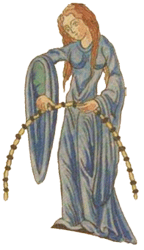Computing rope
The arithmetic rope or knot rope was a common arithmetic aid of the Middle Ages , with the help of which one could solve and demonstrate simple numerical and geometric problems.
A female figure with the attribute of the knotted rope served as an allegorical personification of arithmetic in the representation of the liberal arts .
A computing rope had several knots a hand's breadth apart. It is often incorrectly called a twelve-knot cord . However, a twelve-knot cord is always a closed (ring) cord. More knots in the arithmetic rope were especially beneficial for multiplication and division.
Arithmetic functions
| arithmetic | |||
| addition | X + Y = Z | You first count off X nodes, then Y more. The total number of nodes counted is Z. |
E.g .: 5 + 4 = 9
|
| subtraction | X - Y = Z | You first count off X nodes and then go back Y. The total number of nodes counted is Z. |
E.g .: 9 - 4 = 5
|
| multiplication | X × Y = Z | You count X nodes and put this line Y times together. The total number of nodes counted is Z. |
E.g .: 4 * 3 = 12
|
| division | X / Y = Z (remainder Q) | Count off X nodes. From this you take Y and put them together until they are all used up. The number of merges is Z. The remaining nodes are the remainder Q. |
E.g .: 13/4 = 3 remainder 1
|
| geometry | |||
| Right angle | 4 2 + 3 2 = 5 2 16 + 9 = 25 |
You nail the beginning and end of the computing rope together. For the base side, count down 5 (4 sections) and nail it down. For the vertical on it you need 4 knots (3 sections). Tensioning these sides creates a right-angled triangle (principle of the Pythagorean triple ). If you now fix 3 sections of the right-angled sides (7 nodes) and pull the remaining 5 nodes symmetrically outwards, a square is created. |
|
| Equilateral triangle | You nail the beginning and end of the computing rope together. Count 5 for the base side. For the sides on it you need 5 knots each. Tensioning these sides creates an equilateral triangle. |

|
|
| Circle , hexagon | One end is nailed down and a stylus is attached to the desired location. Then you lead the stylus around once on the taut rope. With the set radius, the arc can easily be divided into a hexagon. | ||
Individual evidence
- ↑ Archived copy ( Memento from March 31, 2010 in the Internet Archive )
- ↑ Archived copy ( Memento from October 23, 2008 in the Internet Archive )
- ↑ Archived copy ( Memento from October 23, 2008 in the Internet Archive )

